Events of Wednesday 7th May 2014
Walking in Yangon
I enjoyed a leisurely breakfast in the Cafe at the Strand Hotel. I managed to contact both Doctor Hla Tun and Captain Myo Lwin on the telephone and we all arranged to meet in my hotel later in the day.
Although still fairly exhausted, I decided I'd take a walk in the city. There's always so much to see and the legacy of Britsh-inspired buildings is a permanent fascination. There's a useful book [reference 1] on Heritage Buildings in Yangon, with the delightful sub-title 'Inside the City that captured Time'. I decided to head north, away from the river but, instead of taking the major thoroughfare Pansodan Street, I took the narrower street to the east, Seikanthar Street. My first discovery was that the side of the Strand Hotel was being cleaned. Four men were clinging to two rather primitive rope ladders with bamboo 'rungs', scrubbing away at the walls. One man on the flat roof was controlling the water supply to two flexible plastic pipes dangling by the cleaners.
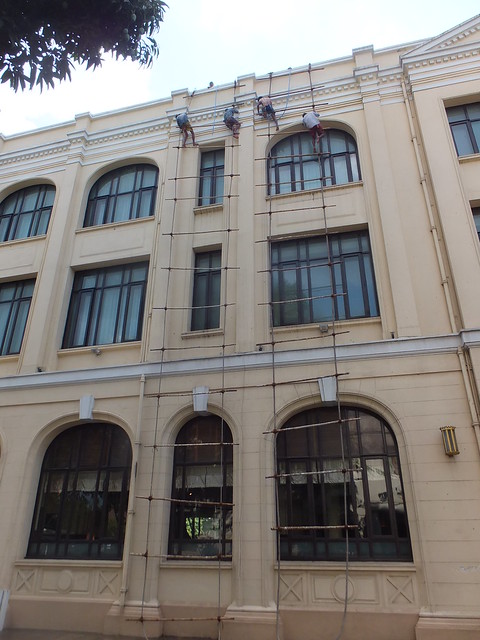
Cleaning the Strand Hotel.
I passed a number of Colonial-era warehouse buildings and a few commercial/residential buildings, none in a very good state of repair. These were interspersed with more modern apartment blocks, usually seven storey.

Seikanthar Street, looking north.
What was most striking was that this appeared to be 'Computer Street'. Most of the ground floor businesses were selling computers, mobile phones, audio equipment or 'white goods'. Rather than the usual crowded jumble of stock, most of the premises were well-lit, western-style showrooms and most of the posters were in English, with only the occasional Burmese text.
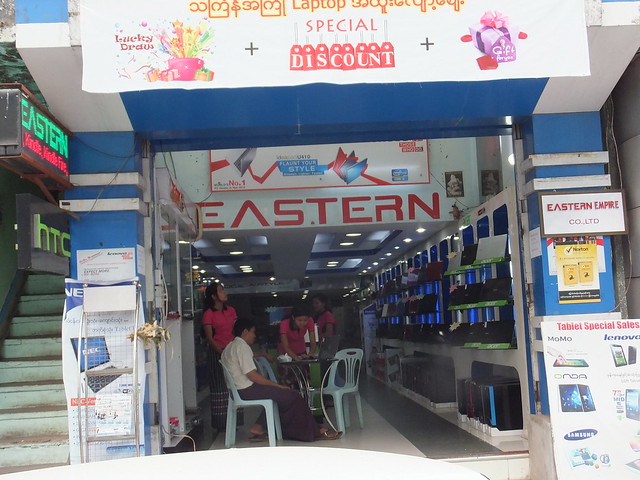 The Computer Showroom of Eastern Empire Co. Ltd.
The Computer Showroom of Eastern Empire Co. Ltd.
Not far from these showrooms selling 'state of the art' products, I passed a more low-tech business - a one-man mobile snack bar. Two specially-made small wooden tables carry two metal pots of food plus accessories. Four metal supports rising from each table are gathered into a supporting ring. The owner has a wooden yoke so that, to move to another location, the supporting ring on each table is threaded onto each end of the yoke and the whole weight can be carried on the owner's shoulders. There were also three small moulded plastic stools for the customers which (elsewhere) I've seen wedged into the framework of the wooden tables whilst the whole set-up was being moved.
 Mobile Snack Bar, Burmese-style.
Mobile Snack Bar, Burmese-style.
Yangon Central Station
Perhaps inevitably, when I reached Bogyoke Aung San Road (which runs east-west, south of the railway), I climbed the steps of the bridge which gives access to the station and descended onto platform 7 (one of the three 'suburban' platforms). One of the new Japanese diesel railcars was standing in the platform, covered in advertising, but before I could draw level, it departed westwards. The rear of the train carried its running number 'RBE-P5032' on one panel and 'Gold Roast COFFEE MIX' on the other - another triumph for marketing, I suppose, just like the ghastly trains with advertising running around in Britain.
 Japanese diesel railcar leaving Yangon Central Station.
Japanese diesel railcar leaving Yangon Central Station.
City Hall
I slowly made my way back towards the hotel, this time using the busy Pansodan Street. At the junction with Mahabandoola Road, I passed City Hall - a curious but imposing confection in Britsh - Myanmar style built in stages between 1925 and 1940 where components of Burmese Palace and Temple architecture have been added-on to a typical British municipal building. In 2011, it was repainted in a striking lilac with purple details.
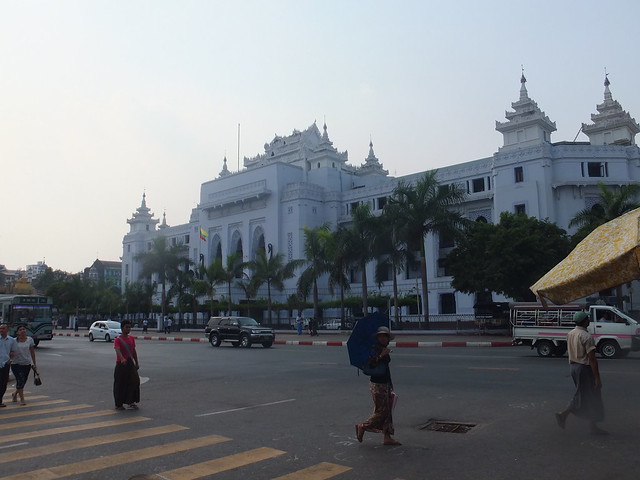 City Hall.
City Hall.
Central Telegraph Office
Built between 1913 and 1917. By 2000, it had lost most of its original roles. It is owned by the Ministry of Communications, Posts and Telgraphs and I believe the ground floor now houses stalls selling mobile phones.
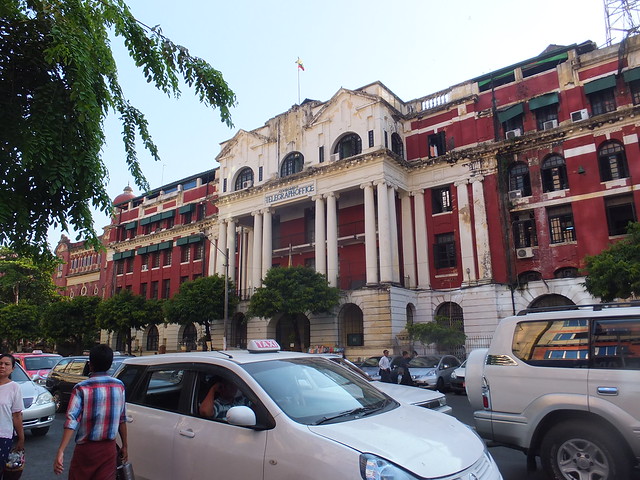 Central Telegraph Office.
Central Telegraph Office.
High Court
This 'archetypal colonial administrative building' was built between 1905 and 1911 and remains in use, although the Supreme Court has moved to Naypyitaw.
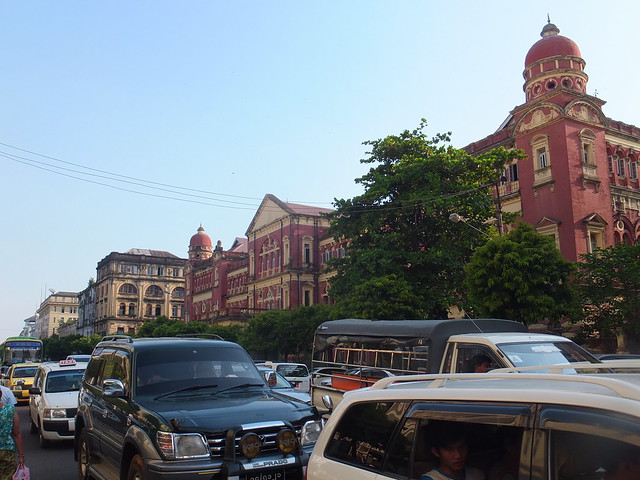 Rear elevation of High Court.
Rear elevation of High Court.
Internal Revenue Department
This building was commissioned by Surti Indian Traders from the port of Rander (hence the name 'Rander House'). It was built in 1932 and, after serving various roles, in now used by Inland Revenue, with apartments in the upper floors.
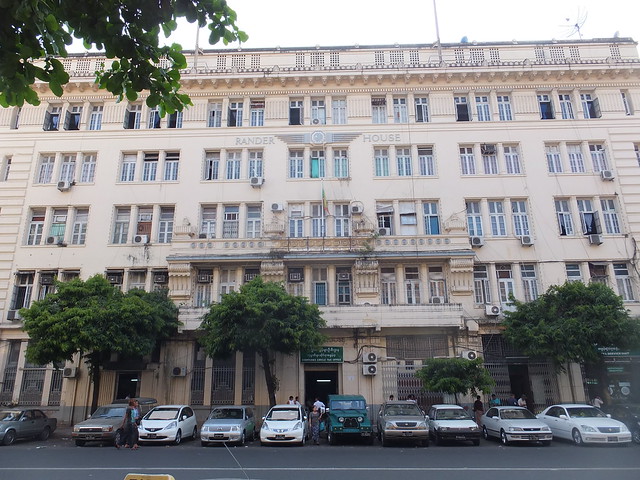 'Rander House', now the Internal Revenue Department.
'Rander House', now the Internal Revenue Department.
Meeting Friends
I was back at the hotel in plenty of time for my visitors Doctor Hla Tun and Captain Myo Lwin. They declined the offer of a meal so, instead, we had soft drinks in the Bar. Soon, it was time to say 'goodbye' to my friends - I was leaving Myanmar early the next morning by air for Doha in Qatar.
Books
[reference 1] '30 Heritage Buildings of Yangon', published by Association of Myanmar Architects in association with Serindia Publications Inc (ISBN 978-1-932476-63-7 Softcover).
My Pictures
Yangon (Rangoon).
(Pictures from March 2008, September 2008, September 2009, September 2012)Yangon (2013).
Around Yangon, 2014.
Strand Hotel, Yangon.
Yangon's Railways
More
Next Post describing this trip.
